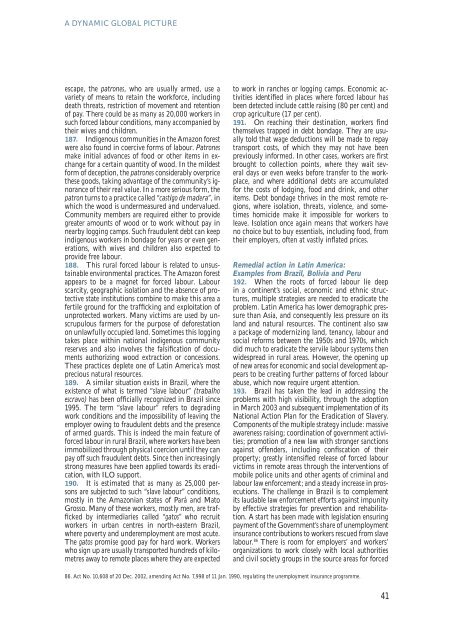A Global Alliance Against Forced Labour - International Labour ...
A Global Alliance Against Forced Labour - International Labour ...
A Global Alliance Against Forced Labour - International Labour ...
You also want an ePaper? Increase the reach of your titles
YUMPU automatically turns print PDFs into web optimized ePapers that Google loves.
A DYNAMIC GLOBAL PICTUREescape, the patrones, who are usually armed, use avariety of means to retain the workforce, includingdeath threats, restriction of movement and retentionof pay. There could be as many as 20,000 workers insuch forced labour conditions, many accompanied bytheir wives and children.187. Indigenous communities in the Amazon forestwere also found in coercive forms of labour. Patronesmake initial advances of food or other items in exchangefor a certain quantity of wood. In the mildestform of deception, the patrones considerably overpricethese goods, taking advantage of the community’s ignoranceof their real value. In a more serious form, thepatron turns to a practice called “castigo de madera”, inwhich the wood is undermeasured and undervalued.Community members are required either to providegreater amounts of wood or to work without pay innearby logging camps. Such fraudulent debt can keepindigenous workers in bondage for years or even generations,with wives and children also expected toprovide free labour.188. This rural forced labour is related to unsustainableenvironmental practices. The Amazon forestappears to be a magnet for forced labour. <strong>Labour</strong>scarcity, geographic isolation and the absence of protectivestate institutions combine to make this area afertile ground for the trafficking and exploitation ofunprotected workers. Many victims are used by unscrupulousfarmers for the purpose of deforestationon unlawfully occupied land. Sometimes this loggingtakes place within national indigenous communityreserves and also involves the falsification of documentsauthorizing wood extraction or concessions.These practices deplete one of Latin America’s mostprecious natural resources.189. A similar situation exists in Brazil, where theexistence of what is termed “slave labour” (trabalhoescravo) has been officially recognized in Brazil since1995. The term “slave labour” refers to degradingwork conditions and the impossibility of leaving theemployer owing to fraudulent debts and the presenceof armed guards. This is indeed the main feature offorced labour in rural Brazil, where workers have beenimmobilized through physical coercion until they canpay off such fraudulent debts. Since then increasinglystrong measures have been applied towards its eradication,with ILO support.190. It is estimated that as many as 25,000 personsare subjected to such “slave labour” conditions,mostly in the Amazonian states of Pará and MatoGrosso. Many of these workers, mostly men, are traffickedby intermediaries called “gatos” who recruitworkers in urban centres in north-eastern Brazil,where poverty and underemployment are most acute.The gatos promise good pay for hard work. Workerswho sign up are usually transported hundreds of kilometresaway to remote places where they are expectedto work in ranches or logging camps. Economic activitiesidentified in places where forced labour hasbeen detected include cattle raising (80 per cent) andcrop agriculture (17 per cent).191. On reaching their destination, workers findthemselves trapped in debt bondage. They are usuallytold that wage deductions will be made to repaytransport costs, of which they may not have beenpreviously informed. In other cases, workers are firstbrought to collection points, where they wait severaldays or even weeks before transfer to the workplace,and where additional debts are accumulatedfor the costs of lodging, food and drink, and otheritems. Debt bondage thrives in the most remote regions,where isolation, threats, violence, and sometimeshomicide make it impossible for workers toleave. Isolation once again means that workers haveno choice but to buy essentials, including food, fromtheir employers, often at vastly inflated prices.Remedial action in Latin America:Examples from Brazil, Bolivia and Peru192. When the roots of forced labour lie deepin a continent’s social, economic and ethnic structures,multiple strategies are needed to eradicate theproblem. Latin America has lower demographic pressurethan Asia, and consequently less pressure on itsland and natural resources. The continent also sawa package of modernizing land, tenancy, labour andsocial reforms between the 1950s and 1970s, whichdid much to eradicate the servile labour systems thenwidespread in rural areas. However, the opening upof new areas for economic and social development appearsto be creating further patterns of forced labourabuse, which now require urgent attention.193. Brazil has taken the lead in addressing theproblems with high visibility, through the adoptionin March 2003 and subsequent implementation of itsNational Action Plan for the Eradication of Slavery.Components of the multiple strategy include: massiveawareness raising; coordination of government activities;promotion of a new law with stronger sanctionsagainst offenders, including confiscation of theirproperty; greatly intensified release of forced labourvictims in remote areas through the interventions ofmobile police units and other agents of criminal andlabour law enforcement; and a steady increase in prosecutions.The challenge in Brazil is to complementits laudable law enforcement efforts against impunityby effective strategies for prevention and rehabilitation.A start has been made with legislation ensuringpayment of the Government’s share of unemploymentinsurance contributions to workers rescued from slavelabour. 86 There is room for employers’ and workers’organizations to work closely with local authoritiesand civil society groups in the source areas for forced86. Act No. 10,608 of 20 Dec. 2002, amending Act No. 7,998 of 11 Jan. 1990, regulating the unemployment insurance programme.41
















